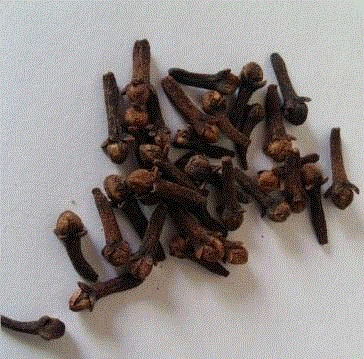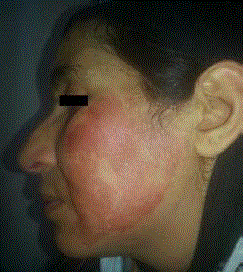Short Communication
Burning Skin on Face Following the Use of Cloves (Syzygium Aromaticum)
Samir El MazouzM1, Abdelmoughit Echchaoui1*, Narjis Badrane2 and Majda Askour3
1Department of Plastic Surgery and Burns, IbnSina University Hospital, Mohamed V University, Morocco
2Poison Control and Pharmacovigilance Centre of Morocco, Morocco
3Department of Dermatologie-Venerology, IbnSina University Hospital, Mohamed V University, Morocco
*Corresponding author: bdelmoughit Echchaoui, Department of Plastic Surgery and Burns, IbnSina University Hospital, Mohamed V University, RABAT 10000, Morocco
Published: 20 Sep, 2017
Cite this article as: El Mazouz S, Echchaoui A, Badrane
N, Askour M. Burning Skin on Face
Following the Use of Cloves (Syzygium
Aromaticum). Clin Surg. 2017; 2: 1620.
Keywords
Cloves; SyzygiumAromaticum; Eugenia Caryophyllata; Eugenol; Burning Skin
Short Communication
Clove (Syzygium aromaticum) (Figure 1) is a plant-derived spice that has been traditionally used
for centuries as food preservative and as medicinal plants [1].
The anti-inflammatory, antioxidant and bactericide activities of clove are mainly due to its
major components, which is the eugenol with a concentration rate ranging from to (77-95%) [2,3].
Clove is generally safe when taken in foods in lower concentrations [4], however, it is not
recommended as a topical application on skin due to insufficiency of safety and toxicity data [5]; it
was found to be highly cytotoxic for human fibroblasts and endothelial cells [6] leading to allergic
skin reactions (burning, hives, itching, irritation, rash…), ulcer formation and/or tissue necrosis [7].
We report a case of a 39-year-old female patient in good overall health presented with Burning
skin on her face following the use of mixture (cloves and water)for an aesthetic purpose.
Physical examination showed a first-degree burn on her left hemiface (Figure 2), homogeneous, Remedy Publications LLC., | http://clinicsinsurgery.com/ 2 2017 Volume 2 | Article 1620
without skin necrosis.
The lesion was successfully treated with topical application of
betasitosterol daily for ten days.
Figure 1
Figure 2
References
- Pulikottil SJ, Nath S. Potential of clove of Syzygiumaromaticum in development of a therapeutic agent for periodontal disease. A review. SADJ. 2015;70(3):108–15.
- Pandey SK, Tandon S, Ahmad A, Singh AK, Tripathi AK. Structure-activity relationships of monoterpenes and acetyl derivates against aedesaegypti (diptera: culicidae) larvae. Pest Man Sci. 2013;69(11): 1235-38.
- Vanin A, Orlando T, Piazza SP, Puton BMS, Cansian RL, Oliveira D, et al. Antimicrobial and antioxidant activities of clove essential oil and eugenyl acetate produced by enzymatic esterification. Applied Bioch Biotech. 2014;174(4):1286-98.
- Cortés-Rojas DF, de Souza CRF, Oliveira WP. Clove (Syzygiumaromaticum): a precious spice. Asian Pacific Journal of Tropical Biomedicine. 2014;4(2):90-6.
- Nataly M. Cloves. J Prim Health Care. 2015;7(2):163.
- Prashar A, Locke IC, Evans CS. Cytotoxicity of clove (Syzygiumaromaticum) oil and its major components to human skin cells. Cell Prolif. 2006;39(4):241-8.
- Sarrami N, Pemberton MN, Thornhill MH, Theaker ED. Adverse reactions associated with the use of eugenol in dentistry. Brit Dent J. 2002;193:257–9.


